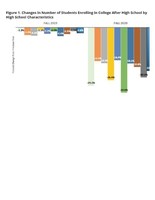HERNDON, Va., Dec. 10, 2020 /PRNewswire/ -- The National Student Clearinghouse Research Center released today the eighth annual High School Benchmarks report that shows far fewer high school graduates went to college immediately after high school this fall, declining by 21.7 percent compared to 2019 graduates.
The High School Benchmarks 2020 - National College Progression Rates updates the key indicators of high school to college transition, persistence, and completion outcomes for high school graduates of 2019 and earlier. In addition, this year's report features a first look at the effect of COVID-19 on the immediate college enrollment patterns of the high school graduating class of 2020. The COVID-19 Special Analysis was funded by the National College Attainment Network.
"Based on preliminary data, there is little evidence that COVID-19 impacted high school graduation," said Doug Shapiro, Executive Director of the National Student Clearinghouse Research Center. "However, the pandemic impacted high school graduates in their immediate college enrollment, and those from high poverty, low income, and urban high schools have been hit the hardest. The enrollment gaps appear to be widening because of COVID-19."
Using preliminary data from high schools and colleges reporting as of September 18, 2020, the immediate enrollment rates are estimated for graduates from more than 2,300 high schools with differing income, minority, and urbanicity characteristics.
Key findings include:
- Preliminary data shows little impact of COVID-19 on high school graduation in the school year 2019-2020.
- Far fewer graduates went to college immediately after high school this fall, declining by 21.7 percent compared to 2019 graduates.
- COVID-19 impacted immediate college enrollment rates considerably for graduates of high poverty, low income, and urban high schools.
- Public college enrollment among graduates of low-income high schools declined at disproportionately higher rates, revealing impediments to college access during COVID-19.
Despite steady high school graduate numbers, students going to college immediately after high school this fall fell steeply by 21.7 percent, nearly eight times the pre-pandemic loss rate (-2.8%).
The degree of impacts tracks closely high schools' income, poverty, and minority levels, as well as urbanicity (See Figure 1 in the report) — a 29.2 percent drop in college enrollment among graduates of low-income high schools versus a 16.9 percent drop at higher-income high schools; -26.4 percent for high-minority versus -18.0 percent for low-minority high schools; -32.6 percent for high-poverty versus -16.4 percent for low-poverty high schools; and -25.1 percent for urban high schools versus -19.8 percent for suburban and -18.1 percent for rural high schools. This fall's declines are far larger than those of the previous year (pre-pandemic).
The immediate college enrollment rate decreased to 27.7 percent from 35.3 percent last fall, a decline ten times steeper than last fall's drop (from 35.9% in 2018 to 35.3% in 2019).
Based on preliminary data representing 53 percent of colleges as of Sept 18, 2020, sharp decreases in the immediate enrollment rate over the same time last year are detected, ranging from 7 to 9 percentage point declines, irrespective of urbanicity, income level or minority level of high schools. The pre-pandemic enrollment rate changes were within +/- 2.5 percentage points.
Public college enrollment among graduates of low-income high schools declined at disproportionately higher rates, revealing impediments to college access during COVID-19.
Although the immediate college enrollments dropped sharply this fall across all institution types (See Figure 6 in the report), enrollment impacts emerge that are attributable to the inequitable effect of the pandemic (See Figure 7 in the report). For example, immediate enrollments across all institution types fell more sharply for low-income high school graduates, by 29.2 percent, compared to a 16.9 percent drop for their counterparts from higher-income high schools.
Furthermore, low-income high school graduates' enrollments declined in public colleges at considerably higher percentages than graduates of higher-income high schools (-20.5% versus -10.7% at public four-year colleges; and -37.1% versus -21.8% at community colleges). In contrast, their counterparts at higher-income high schools show relatively larger enrollment drops in private four-year colleges than in public institutions.
The Research Center's Executive Director Doug Shapiro will address these findings during the National College Attainment Network's webinar, "Is the High School to College Pipeline Broken? The Data Says Yes," on Thursday, Dec. 10, at 2 pm ET. Register to attend.
Background
The High School Benchmarks 2020 - National College Progression Rates draws data from the Clearinghouse's StudentTracker® for High Schools' service. It presents findings for students from differing high school characteristics, such as low- versus higher-income, and low versus high minority high schools. To offer more timely information during the COVID-19, many high schools voluntarily submitted their 2020 graduate data early this fall, which made this COVID-19 Special Analysis possible.
About the National Student Clearinghouse® Research Center™
The National Student Clearinghouse Research Center is the research arm of the National Student Clearinghouse. The Research Center collaborates with higher education institutions, states, school districts, high schools, and educational organizations as part of a national effort to better inform education leaders and policymakers. Through accurate longitudinal data outcomes reporting, the Research Center enables better educational policy decisions leading to improved student outcomes. To learn more, visit http://nscresearchcenter.org.
CONTACT: Todd Sedmak, [email protected]
SOURCE National Student Clearinghouse Research Center

Related Links
WANT YOUR COMPANY'S NEWS FEATURED ON PRNEWSWIRE.COM?
Newsrooms &
Influencers
Digital Media
Outlets
Journalists
Opted In

Share this article